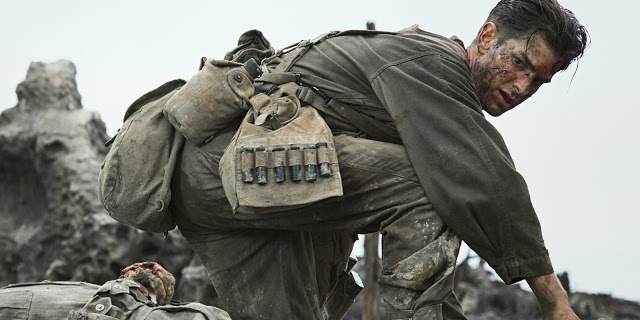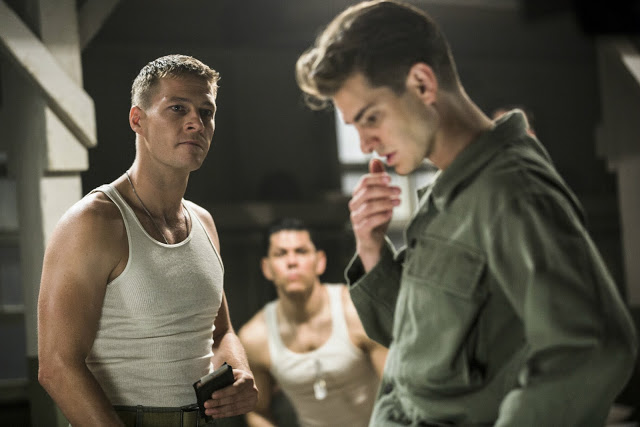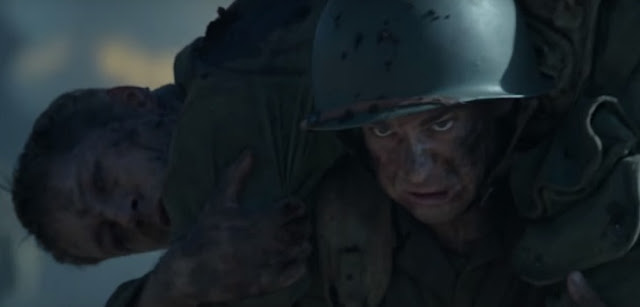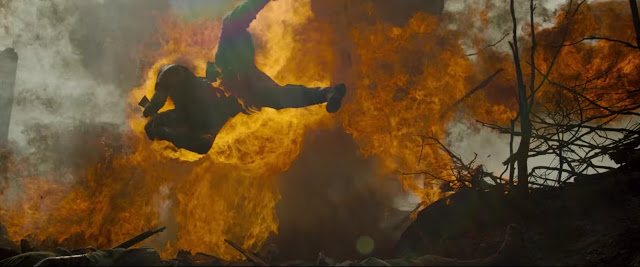Early in Hacksaw Ridge, a jittery blood donor attempts to impress a pretty nurse with a spectacularly cheesy pickup line. Yesterday, when she jabbed a needle into his arm, was the first time they’d met; today, he insists that he needs a transfusion because ever since he saw her, his heart’s been beating so fast that he’s nearly out of blood. “That’s pretty corny,” she responds, but when he asks if that makes it bad, she blushes and continues, “I didn’t say that.” Hacksaw Ridge, the fifth movie directed by Mel Gibson, is also pretty corny—OK, it’s very corny. It is also sappy, grandiose, and preachy. Does that make it bad? Not by a long shot.
That aforementioned blood donor is Desmond Doss, played as an adult with sly, aw-shucks charm by Andrew Garfield. We first meet him as a boy (portrayed by Darcy Bryce) in Virginia’s Blue Ridge Mountains, where he roughhouses with his brother before inadvertently knocking him unconscious. Fearing for his sibling’s life, the young sinner slumps into an adjoining room, where he gazes at a crude illustration of a murder, ornamented with the text of one of the Commandments: “Thou shalt not kill.” This blunt, didactic sequence quickly establishes two things: one, Doss will grow up to be a deeply religious pacifist, and two, Gibson has no use for subtlety.
Well, who needs it? As an actor, Gibson can bring ripples of feeling and unpredictability to his work; for a recent example, look no further than Blood Father, where he imbued his role as a cantankerous, alcoholic ex-con with macabre humor and pangs of regret. But as a director, he paints in bold, brash colors, using durable cinematic techniques to conjure intense emotions. It’s a style that could be viewed as manipulative—he is the invisible hand, guiding you gently but purposefully toward his chosen destination—if he weren’t so damn good at it. Hacksaw Ridge may be ostentatious and overflowing with religious symbolism, but there’s an undeniable power to its pageantry.
Not to suggest that this movie is turgid. That would discount the contributions of Garfield, a performer who typically burrows into his characters; here, he brings an impish playfulness to the part of Doss, a buoyancy that nicely counterbalances the film’s overall gravity. Doss’ early courtship of that nurse, Dorothy (an appealing Teresa Palmer), is positively adorable, the sort of Old Hollywood romancing that obliterates your anti-schmaltz defenses through sheer sweetness and goodwill. But Hacksaw Ridge is a war movie, not a love story. Once he sees newsreel footage of the escalating conflict that would come to be called World War II, Doss, despite his adherence to nonviolence, feels compelled to enlist. His theory, which does little to mollify his sullen and tormented father (Hugo Weaving), a veteran of the Great War: He can serve as a medic, restoring life when those around him are raining death.
The Army has other ideas. Although Doss proves a capable soldier (no stranger to playing skinny leapers, Garfield here showcases a wiry athleticism), his refusal to pick up a rifle predictably draws the ire of his unit mates, not to mention his two COs, Sergeant Howell (Vince Vaughn, putting a faintly comic spin on R. Lee Ermey’s iconic drill instructor from Full Metal Jacket) and Captain Glover (Sam Worthington, working within his range). This philosophical schism—Doss dubs himself a “conscientious collaborator”, but his fellow combatants brand him a coward and heartily encourage him to quit—allows Hacksaw Ridge to advance multiple agendas at once. In one sense, it is a classic platoon picture, exploring the bonds and fissures that develop between men at arms. (In this, it bears strong similarities to We Were Soldiers, Randall Wallace’s underrated Vietnam film in which Gibson played a square-jawed colonel.) In another, it is a story about personal freedom, and the cost of holding fast to your religious beliefs in the face of ignorance, derision, and abuse.
It stumbles slightly on both fronts. Screenwriters Andrew Knight and Robert Schenkkan do a fine job presenting Doss as a person rather than a saint, but he’s the only figure in the movie with any real depth. Despite Gibson’s obvious goal of depicting a military brotherhood—a unit whose camaraderie is defined by casual wisecracking and fraternal loyalty—none of Doss’ comrades makes much of an impression, with the partial exception of Smitty (Luke Bracey), a beefy warrior whose primary narrative function is to grudgingly come to appreciate Doss’ integrity and courage. Meanwhile, Gibson’s handling of Doss’ legal tribulations—he eventually faces a court-martial for refusing to obey orders—is heavy-handed, and without the eye-popping artistry of the battle sequences to make things more palatable.
Soon enough, however, Hacksaw Ridge departs the sunny comforts of America for the cloudy shores of Okinawa (filming took place in Australia), and Gibson reminds us of what he can do. This is his first feature in a decade, and in the interim, he has battled his share of demons. But he has always been a talented and muscular filmmaker, and his gifts haven’t left him. There are so many war movies, it is difficult to make a new one that possesses any real cinematic character, but here, Gibson has crafted something that is both proudly old-fashioned and gruesomely modern.
It has become fashionable to praise incursion pictures by equating them with Saving Private Ryan, but while Hacksaw Ridge is uncompromisingly brutal, the Steven Spielberg film it most resembles is War Horse. As in that grand, touching saga of capture and escape, Gibson elevates the horror of his carnage with classical beauty and formal audacity. He is especially fond of slow-motion, and while many of the movie’s images are undeniably showy—bodies tumbling artfully through the air; rats feasting on gory appendages; orange-yellow flames erupting from every corner of the frame—they only serve to deepen its profound sense of terror and loss. What’s more, Gibson never yields to the temptation of sensory bombardment, instead striking a canny balance between chaos and precision. An assault on a machine-gun bunker is expertly choreographed, while a latter sequence—in which an injured soldier finds his entire body buried under dirt except for a single, unblinking eyeball—is heart-pounding in its suspense.
In the middle of everything, dispensing morphine and bandaging wounds, is Doss, our wide-eyed surrogate and improbably unarmed hero. There is obvious dissonance in a movie about a pacifist that nevertheless traffics in such relentless bloodletting. Of course, this inherent conflict is also the film’s point. In struggling to save his comrades, Doss is spotlighting the nobility of nonviolence and decrying the futility of war. It’s not the most sophisticated theme, but once again, the execution carries the day; the final act of Hacksaw Ridge is a visual and conceptual coup, with Doss using his guile and fortitude in a rousing display of bravery. (This is only augmented by Rupert Gregson-Williams’ stirring, syrupy score, which plainly channels the late James Horner, who composed the music for three of Gibson’s previous films.)
At times, particularly during its treacly denouement, Hacksaw Ridge‘s persistent solemnity and spirituality can become excessive. Gibson may not have a Messiah complex, but that doesn’t prevent him from casting Doss as a Christlike figure, whether it’s framing him from above as he’s outstretched on a litter or giving him a metaphoric baptism when water pours down from above, cleansing him of blood. (Remember, this is the guy who made millions when he self-financed The Passion of the Christ.) And as enjoyable and skillfully crafted as Hacksaw Ridge may be, it lacks the clever plotting and rich humor of Braveheart, and it cannot match the innovative brutality of Apocalypto. (It may also be criticized for its less-than-flattering portrait of Japanese soldiers.) But I have no quarrel with a filmmaker using art to advance a religious message, especially when the message is so serene, and the art so forceful.
In one of Hacksaw Ridge‘s most giddily over-the-top moments, an enemy lobs a grenade at Doss, who instinctively swats it away in mid-air, like a power forward blocking a shot. It’s a ludicrous scene, but it somehow fits perfectly within the context of the film’s sweeping grandeur. It also taps in to the movie’s overall feelings of triumph and vindication. The latter doesn’t necessarily apply to Doss—he opens the film a laughingstock and ends it a hero, but we know he was right all along. No, it’s his director who has found redemption.
Jeremy Beck is the editor-in-chief of MovieManifesto. He watches more movies and television than he probably should.




